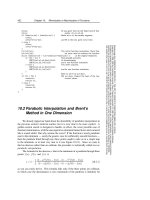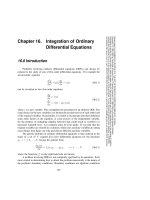Tài liệu Logic Synthesis With Verilog HDL part 3 doc
Bạn đang xem bản rút gọn của tài liệu. Xem và tải ngay bản đầy đủ của tài liệu tại đây (33.66 KB, 9 trang )
[ Team LiB ]
14.4 Synthesis Design Flow
Having understood how basic Verilog constructs are interpreted by the logic synthesis
tool, let us now discuss the synthesis design flow from an RTL description to an
optimized gate-level description.
14.4.1 RTL to Gates
To fully utilize the benefits of logic synthesis, the designer must first understand the flow
from the high-level RTL description to a gate-level netlist. Figure 14-4
explains that
flow.
Figure 14-4. Logic Synthesis Flow from RTL to Gates
Let us discuss each component of the flow in detail.
RTL description
The designer describes the design at a high level by using RTL constructs. The designer
spends time in functional verification to ensure that the RTL description functions
correctly. After the functionality is verified, the RTL description is input to the logic
synthesis tool.
Translation
The RTL description is converted by the logic synthesis tool to an unoptimized,
intermediate, internal representation. This process is called translation. Translation is
relatively simple and uses techniques similar to those discussed in Section 14.3.3
,
Interpretation of a Few Verilog Constructs. The translator understands the basic
primitives and operators in the Verilog RTL description. Design constraints such as area,
timing, and power are not considered in the translation process. At this point, the logic
synthesis tool does a simple allocation of internal resources.
Unoptimized intermediate representation
The translation process yields an unoptimized intermediate representation of the design.
The design is represented internally by the logic synthesis tool in terms of internal data
structures. The unoptimized intermediate representation is incomprehensible to the user.
Logic optimization
The logic is now optimized to remove redundant logic. Various technology independent
boolean logic optimization techniques are used. This process is called logic optimization.
It is a very important step in logic synthesis, and it yields an optimized internal
representation of the design.
Technology mapping and optimization
Until this step, the design description is independent of a specific target technology. In
this step, the synthesis tool takes the internal representation and implements the
representation in gates, using the cells provided in the technology library. In other words,
the design is mapped to the desired target technology.
Suppose you want to get your IC chip fabricated at ABC Inc. ABC Inc. has 0.65 micron
CMOS technology, which it calls abc_100 technology. Then, abc_100 becomes the target
technology. You must therefore implement your internal design representation in gates,
using the cells provided in abc_100 technology library. This is called technology
mapping. Also, the implementation should satisfy such design constraints as timing, area,
and power. Some local optimizations are done to achieve the best results for the target
technology. This is called technology optimization or technology-dependent
optimization.
Technology library
The technology library contains library cells provided by ABC Inc. The term standard
cell library used earlier in the chapter and the term technology library are identical and
are used interchangeably.
To build a technology library, ABC Inc. decides the range of functionality to provide in
its library cells. As discussed earlier, library cells can be basic logic gates or macro cells
such as adders, ALUs, multiplexers, and special flip-flops. The library cells are the basic
building blocks that ABC Inc. will use for IC fabrication. Physical layout of library cells
is done first. Then, the area of each cell is computed from the cell layout. Next, modeling
techniques are used to estimate the timing and power characteristics of each library cell.
This process is called cell characterization.
Finally, each cell is described in a format that is understood by the synthesis tool. The
cell description contains information about the following:
•
Functionality of the cell
•
Area of the cell layout
•
Timing information about the cell
•
Power information about the cell
A collection of these cells is called the technology library. The synthesis tool uses these
cells to implement the design. The quality of results from synthesis tools will typically be
dominated by the cells available in the technology library. If the choice of cells in the
technology library is limited, the synthesis tool cannot do much in terms of optimization
for timing, area, and power.
Design constraints
Design constraints typically include the following:
•
Timing— The circuit must meet certain timing requirements. An internal static
timing analyzer checks timing.
•
Area— The area of the final layout must not exceed a limit.
•
Power— The power dissipation in the circuit must not exceed a threshold.
In general, there is an inverse relationship between area and timing constraints. For a
given technology library, to optimize timing (faster circuits), the design has to be
parallelized, which typically means that larger circuits have to be built. To build smaller
circuits, designers must generally compromise on circuit speed. The inverse relationship
is shown in Figure 14-5
.
Figure 14-5. Area vs. Timing Trade-off
On top of design constraints, operating environment factors, such as input and output
delays, drive strengths, and loads, will affect the optimization for the target technology.
Operating environment factors must be input to the logic synthesis tool to ensure that
circuits are optimized for the required operating environment.
Optimized gate-level description
After the technology mapping is complete, an optimized gate-level netlist described in
terms of target technology components is produced. If this netlist meets the required
constraints, it is handed to ABC Inc. for final layout. Otherwise, the designer modifies the
RTL or reconstrains the design to achieve the desired results. This process is iterated until
the netlist meets the required constraints. ABC Inc. will do the layout, do timing checks
to ensure that the circuit meets required timing after layout, and then fabricate the IC chip
for you.
There are three points to note about the synthesis flow.
1. For very high speed circuits like microprocessors, vendor technology libraries may
yield nonoptimal results. Instead, design groups obtain information about the
fabrication process used by the vendor, for example, 0.65 micron CMOS process,
and build their own technology library components. Cell characterization is done
by the designers. Discussion about building technology libraries and cell
characterization is beyond the scope of this book.
2. Translation, logic optimization, and technology mapping are done internally in the
logic synthesis tool and are not visible to the designer. The technology library is
given to the designer. Once the technology is chosen, the designer can control only
the input RTL description and design constraint specification. Thus, writing
efficient RTL descriptions, specifying design constraints accurately, evaluating
design trade-offs, and having a good technology library are very important to
produce optimal digital circuits when using logic synthesis.
3. For submicron designs, interconnect delays are becoming a dominating factor in
the overall delay. Therefore, as geometries shrink, in order to accurately model
interconnect delays, synthesis tools will need to have a tighter link to layout, right
at the RTL level. Timing analyzers built into synthesis tools will have to account
for interconnect delays in the total delay calculation.
14.4.2 An Example of RTL-to-Gates
Let us discuss synthesis of a 4-bit magnitude comparator to understand each step in the
synthesis flow. Steps of the synthesis flow such as translation, logic optimization, and
technology mapping are not visible to us as designers. Therefore, we will concentrate on
the components that are visible to the designer, such as the RTL description, technology
library, design constraints, and the final, optimized, gate-level description.
Design specification
A magnitude comparator checks if one number is greater than, equal to, or less than
another number. Design a 4-bit magnitude comparator IC chip that has the following
specifications:
•
The name of the design is magnitude_comparator
•
Inputs A and B are 4-bit inputs. No x or z values will appear on A and B inputs
•
Output A_gt_B is true if A is greater than B
•
Output A_lt_B is true if A is less than B
•
Output A_eq_B is true if A is equal to B
•
The magnitude comparator circuit must be as fast as possible. Area can be
compromised for speed.
RTL description
The RTL description that describes the magnitude comparator is shown in Example 14-1
.
This is a technology-independent description. The designer does not have to worry about
the target technology at this point.
Example 14-1 RTL for Magnitude Comparator
//Module magnitude comparator
module magnitude_comparator(A_gt_B, A_lt_B, A_eq_B, A, B);
//Comparison output
output A_gt_B, A_lt_B, A_eq_B;
//4-bits numbers input









